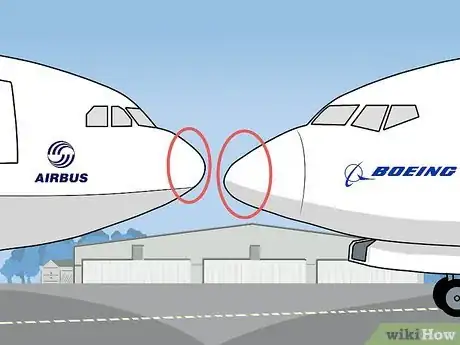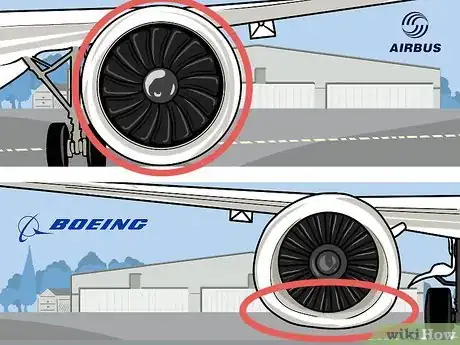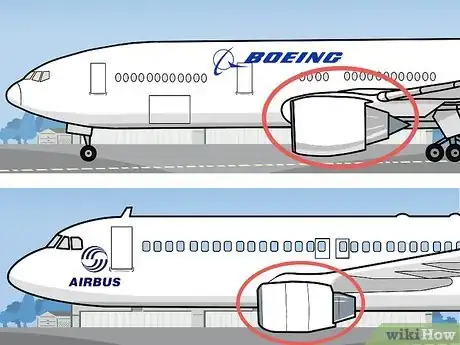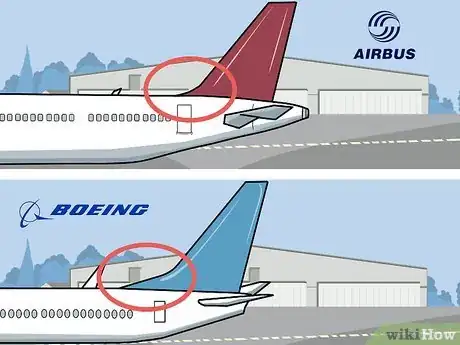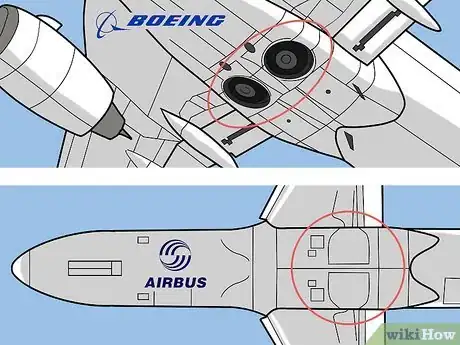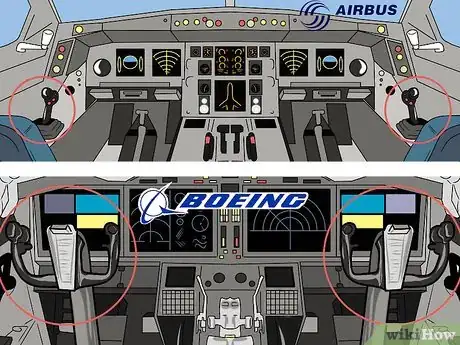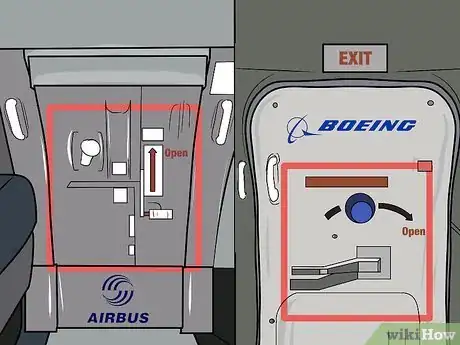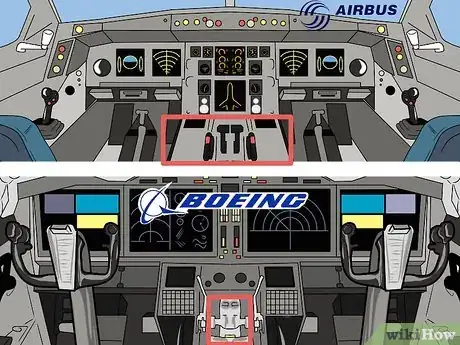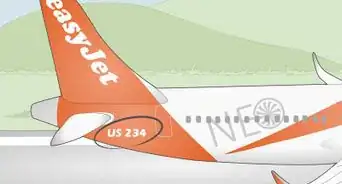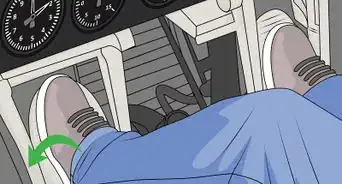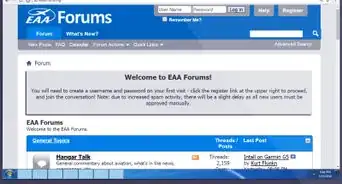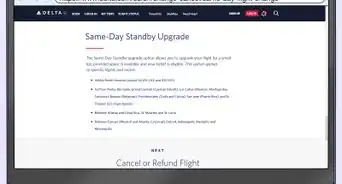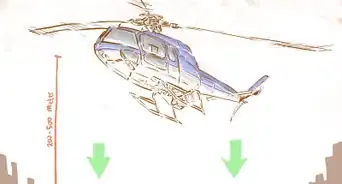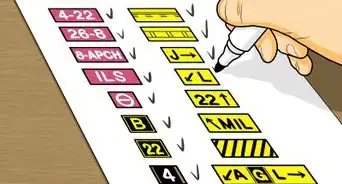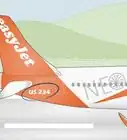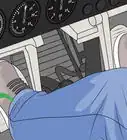wikiHow is a “wiki,” similar to Wikipedia, which means that many of our articles are co-written by multiple authors. To create this article, volunteer authors worked to edit and improve it over time.
This article has been viewed 75,420 times.
Learn more...
Boeing and Airbus are the two largest aircraft manufacturers. Their aircraft, used worldwide, is the backbone of the aviation industry. However, if you ever come across an airplane at the airport, you might have some trouble identifying if it’s an Airbus or a Boeing. In this wikiHow, you will learn some easy techniques to tell them apart.
Steps
Examining the Exterior
-
1Look at the cockpit windows. The cockpit windows are easy ways to identify whether an aircraft is a Boeing or an Airbus. Take a look at the side of the windows, especially the angle of the last window pane. [1]
- Check to see if the side point of the conjoining of the last two window panes are angular. If the conjoining angles of the two side windows are wide and less square, it is probably a Boeing.
- Check if the side of the last window pane has a sharp angle. If the window pane has a right angle (90º) or is close to a right angle at its intersection with the body of the aircraft, it's probably an Airbus.
-
2Look at the nose of the airplane. The nose, or the tip of the airplane, is another good sign to see if an airplane is Boeing or Airbus. [2]
- Check to see if the nose of the airplane is sharp and not round. Boeings have sharper and more pointy noses compared to an Airbus. So if the nose of the aircraft is sharp, it's probably a Boeing.
- Check to see if the nose of the airplane is round. If the nose is round and resembles a semi-circle, it is probably an Airbus.
Advertisement -
3Look at the engines. Engines of Boeing and Airbus greatly differ from each other. Their size and shape are very different and is a telltale sign to identify whether a plane is Boeing or Airbus.[3]
- Check to see if the engines have a flat bottom. Boeing engines tend to have a very flat bottom and a more circular top.
- Check to see if the engines are circular all the way. Airbus engines have a very circular engine, almost a perfect circle.
Exception: There is an exception to this, as the Boeing 777, 767, 747, and 787 have round engines, similar to one of an Airbus; the engines usually work only as an identifier for the Boeing 737, and not other Boeing jets.
-
4Look at the placement of the engines on their aircraft. Boeing and Airbus engines are placed differently. [4]
- Check to see if the engines are mounted forward. A Boeing's engine is placed at the front of the wing, not in the middle or under.
- Check to see if the engines are mounted under the wing. An Airbus's engine is placed fully under the wing, so the engine is more visible if you sit closer to the rear of the plane.
-
5Look if the tail, or the fin at the back of the plane, has a slope when it reaches the plane's body. [5]
- Check to see if the tail of the plane reaches the plane's body with an extended slope. If the tail of the plane reaches the plane with an extension, causing the tail to connect with the plane less sharply, it is probably a Boeing.
- Check to see if the tail of the plane connects with the plane sharply. This means that the tail reaches the plane's body with no extended slop. If it doesn't have a slope, it is an Airbus.
-
6Look at the back gear retraction of the airplane to identify if it is a Boeing 737. This is difficult to examine since this only works when a plane is taking off.
- Check to see if the back gears do not have a compartment and are visible from under the plane. The Boeing 737 (only the 737) back gears retract into the plane, but are not covered up.
- Check to see if the back gears retract into a compartment. An Airbus's gear and most other Boeing aircraft (with the exception of the 737) retracts into the plane and is soon covered up, so the gear is not visible after they retract.
Examining Other Aspects
-
1Take a look at the cockpit, if possible. Although this might not be permitted, it is, sometimes, possible to take a look at the cockpit.
- Check to see if the airplane has a control column, also known as a yoke. A yoke is similar to a "U" shaped steering wheel, located at the front-center of both seats in the cockpit. [6]
- Check to see if a plane has a control column. If the plane doesn't have a control column, it is most likely an Airbus. Take a look at the right side of the right seat (or the left side of the left seat) to see if there is a sidestick. A sidestick looks very similar to a joystick.
Exception: While almost all Airbus's have sidesticks, the Airbus A220 has a yoke. This is due to the origins of the aircraft, which was designed by Canadian company Bombardier.
-
2Look at the design of the emergency exits. There is a major difference between the way Boeing's emergency exits are designed and an Airbus's design.
- Check the handle of the emergency exit If the airplane's emergency exits have a big spinning latch, it is probably a Boeing.
- Check the handle of the emergency exit. If the plane's emergency exits don't have a big handle, but a vertical push handle, it is probably an Airbus.
-
3Take a look at the space inside of the cockpit, if possible. Boeing and Airbus cockpits differ in their size. [7]
- Examine the space between the Captain's and First Officer's seats. A Boeing tends to have less space between the two seats as well as the overall space in the cockpit.
- Examine the space between the captain's and first officer's seats. An Airbus has a greater amount of space between the seats, and its cockpits are more spacious than a Boeing's
Community Q&A
-
QuestionIs Boeing an older company or is Airbus?
 Community AnswerBoeing is the older of the two. Boeing was founded by William Boeing in the early 1900s, while Airbus was founded in the 1970s.
Community AnswerBoeing is the older of the two. Boeing was founded by William Boeing in the early 1900s, while Airbus was founded in the 1970s. -
QuestionIs the front gear on a Boeing visible after it takes off?
 WikiaWangTop AnswererOnly the 737 has the gear doors visible -- not all Boeings. In others, the front gear retracts into a compartment and is no longer visible after it retracts.
WikiaWangTop AnswererOnly the 737 has the gear doors visible -- not all Boeings. In others, the front gear retracts into a compartment and is no longer visible after it retracts. -
QuestionWhy are some Boeing aircraft engines flat on the bottom?
 🛫 Mattheus Goldman 🛬Community AnswerIt varies on aircraft, and what kind of engine it is. However, the primary reason is due to how low the landing gears of the aircraft are, and having a flat bottom prevents the engine from scraping on the ground. Mostly, this is found in the 737 family, mostly the Next Generation (700, 800, 900) and the MAX series. However, it can be found on other low dragging aircrafts more commonly.
🛫 Mattheus Goldman 🛬Community AnswerIt varies on aircraft, and what kind of engine it is. However, the primary reason is due to how low the landing gears of the aircraft are, and having a flat bottom prevents the engine from scraping on the ground. Mostly, this is found in the 737 family, mostly the Next Generation (700, 800, 900) and the MAX series. However, it can be found on other low dragging aircrafts more commonly.
References
- ↑ https://www.youtube.com/watch?v=RNinfd8NJHI&t=89s
- ↑ https://www.youtube.com/watch?v=RNinfd8NJHI&t=89s
- ↑ https://www.youtube.com/watch?v=RNinfd8NJHI&t=89s
- ↑ https://wonderfulengineering.com/these-are-the-major-design-differences-between-airbus-and-boeing-aircrafts/
- ↑ https://www.youtube.com/watch?v=RNinfd8NJHI&t=89s
- ↑ http://www.differencebetween.info/difference-between-airbus-and-boeing
- ↑ https://www.youtube.com/watch?v=UEMfh-0kRJo&t=479s

